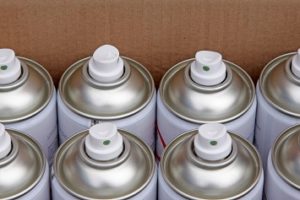Yesterday we discussed options for disposing of aerosol cans. However, you may be able to mitigate or even avoid the costs of disposal and safety concerns related to aerosol cans by looking for alternatives and through waste minimization.
Seek Out Alternatives
There are some ways you can reduce the use of aerosols, including:
Practice tip 1: Minimize the number of different aerosol products used.
Practice tip 2: Conduct aerosol inventories to determine which aerosols are essential to your business, and stop purchasing nonessential aerosol products, especially those containing hazardous constituents.
Practice tip 3: Whenever possible, use rechargeable or pump-spray containers or refillable containers that use compressed air as the propellant instead of aerosols.
Practice tip 4: Replace aerosol products that contain hazardous constituents with nonhazardous products.
Practice tip 5: Decline to accept free samples of aerosols that contain hazardous materials, either in the product or as the propellant.
Waste Minimization
If you find that you cannot eliminate aerosol cans at your facility, there are a few ways you can minimize waste and the threat of explosions and fire.
Practice tip 1: Train your workers to hold aerosol cans upright when using them to maximize the use of the contained product.
Practice tip 2: Use only as much as is needed.
Practice tip 3: Store aerosol containers away from moisture, sunlight, and extreme heat or cold.
Practice tip 4: Follow the label instructions to clean the nozzle after each use.
Practice tip 5: Use the entire contents of a container before buying others.
Practice tip 6: Purchase according to demand so that the product’s shelf life does not expire.
Practice tip 7: Consider purchasing products in bulk and using either a refillable container with compressed air as the propellant or a nonaerosol pump applicator.
Practice tip 8: Return defective aerosol cans to the supplier or manufacturer; otherwise, manage them as hazardous waste.
Practice tip 9: Unclog or replace clogged aerosol can nozzles; otherwise, manage aerosol cans with clogged nozzles as hazardous waste.
Practice tip 10: Recycle empty aerosol containers.
Aerosol Air Issues—It’s a SNAP
Aerosols is one group for which the Environmental Protection Agency (EPA) has reviewed and identified substitutes under the Clean Air Act’s (CAA) Significant New Alternatives Policy (SNAP) program. The purpose of the SNAP program is to allow transition away from ozone-depleting substances (ODSs) by identifying substitutes that offer lower overall risks to human health and the environment.
Lists of acceptable and unacceptable substitutes are updated by the EPA several times each year. These lists include substitutes that are either:
- Acceptable, which means that they may be used without restriction in specific end uses.
- Acceptable subject to narrowed use limits, which means that a substitute may be used only within certain specialized applications within sector end use and may not be used for other applications within an end use or sector. For example, some alternative fire suppressants may be used as total flooding agents in normally unoccupied areas but not in occupied areas.
- Acceptable subject to use conditions, which means that a substitute is acceptable only if used in a certain way. For example, a substitute may be acceptable provided it is used with unique equipment fittings.
The EPA has a list of SNAP alternatives for aerosol propellants and a list of SNAP alternatives for aerosol solvent.

